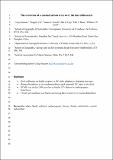Files in this item
The evolution of a coastal carbon store over the last millennium
Item metadata
| dc.contributor.author | Smeaton, Craig | |
| dc.contributor.author | Cui, Xingqian | |
| dc.contributor.author | Bianchi, Thomas | |
| dc.contributor.author | Cage, Alix | |
| dc.contributor.author | Howe, John | |
| dc.contributor.author | Austin, William | |
| dc.date.accessioned | 2022-07-12T23:39:30Z | |
| dc.date.available | 2022-07-12T23:39:30Z | |
| dc.date.issued | 2021-08-14 | |
| dc.identifier | 274904374 | |
| dc.identifier | 417789eb-9273-4813-8cae-1333602be9a7 | |
| dc.identifier | 85109947994 | |
| dc.identifier | 000684295900006 | |
| dc.identifier.citation | Smeaton , C , Cui , X , Bianchi , T , Cage , A , Howe , J & Austin , W 2021 , ' The evolution of a coastal carbon store over the last millennium ' , Quaternary Science Reviews , vol. 266 , 107081 . https://doi.org/10.1016/j.quascirev.2021.107081 | en |
| dc.identifier.issn | 0277-3791 | |
| dc.identifier.other | ORCID: /0000-0003-4535-2555/work/97129889 | |
| dc.identifier.uri | https://hdl.handle.net/10023/25657 | |
| dc.description | This work was financially supported by the Natural Environment Research Council (grant number: NE/L501852/1), the EU FPV HOLSMEER project (EVK2-CT-2000-00060) and the EU FPVI Millennium project (contract number 017008), Biotechnology and Biological Sciences Research Council (grant number: BB/M026620/1) with additional support from the NERC Radiocarbon Facility (Allocation 1154.1005 and 2195.1019). | en |
| dc.description.abstract | Fjord sediments are recognized as hotspots for the burial and storage of organic carbon, yet little is known about the long-term drivers of significant terrestrial organic carbon (OC) transfers into these coastal carbon stores. The mid-latitude fjord catchments of Scotland have a long history of human occupation and environmental disturbance. We provide new evidence to show that increased anthropogenic disturbances over the last 500 years appear to have driven a step change in the magnitude of terrestrial OC transported to the coastal ocean. Increased pressures from mining, agriculture and forestry over the latter half of the last millennium have destabilized catchment soils and remobilized deep stores of aged OC from the catchment to the coastal ocean. Here we show that fjord sediments are capable of acting as highly responsive and effective terrestrial OC sinks, with OC accumulation rates increasing up to 20 % during the peak period of anthropogenic disturbance. The responsiveness and magnitude of the fjord OC sink represents a potentially significant time-evolving component of the global carbon cycle that is currently not recognized but has the potential to become increasingly important in the understanding of the role of these coastal carbon stores in our climate system. | |
| dc.format.extent | 12 | |
| dc.format.extent | 1796487 | |
| dc.language.iso | eng | |
| dc.relation.ispartof | Quaternary Science Reviews | en |
| dc.subject | Carbon | en |
| dc.subject | Fjords | en |
| dc.subject | Sediment | en |
| dc.subject | Anthropogenic | en |
| dc.subject | Human | en |
| dc.subject | Climate | en |
| dc.subject | Mid-latitude | en |
| dc.subject | Coastal | en |
| dc.subject | Radiocarbon | en |
| dc.subject | QE Geology | en |
| dc.subject | GE Environmental Sciences | en |
| dc.subject | GC Oceanography | en |
| dc.subject | Geochemistry and Petrology | en |
| dc.subject | Global and Planetary Change | en |
| dc.subject | Oceanography | en |
| dc.subject | DAS | en |
| dc.subject | SDG 14 - Life Below Water | en |
| dc.subject | SDG 13 - Climate Action | en |
| dc.subject | SDG 15 - Life on Land | en |
| dc.subject.lcc | QE | en |
| dc.subject.lcc | GE | en |
| dc.subject.lcc | GC | en |
| dc.title | The evolution of a coastal carbon store over the last millennium | en |
| dc.type | Journal article | en |
| dc.contributor.sponsor | Scottish Government | en |
| dc.contributor.sponsor | European Commission | en |
| dc.contributor.sponsor | BBSRC | en |
| dc.contributor.institution | University of St Andrews. School of Geography & Sustainable Development | en |
| dc.contributor.institution | University of St Andrews. Environmental Change Research Group | en |
| dc.contributor.institution | University of St Andrews. Bell-Edwards Geographic Data Institute | en |
| dc.contributor.institution | University of St Andrews. Scottish Oceans Institute | en |
| dc.contributor.institution | University of St Andrews. Coastal Resources Management Group | en |
| dc.contributor.institution | University of St Andrews. Marine Alliance for Science & Technology Scotland | en |
| dc.contributor.institution | University of St Andrews. St Andrews Sustainability Institute | en |
| dc.identifier.doi | 10.1016/j.quascirev.2021.107081 | |
| dc.description.status | Peer reviewed | en |
| dc.date.embargoedUntil | 2022-07-13 | |
| dc.identifier.url | https://www.sciencedirect.com/science/article/pii/S0277379121002882?via%3Dihub#appsec1 | en |
| dc.identifier.grantnumber | en | |
| dc.identifier.grantnumber | 017008 | en |
| dc.identifier.grantnumber | BB/M026620/1 | en |
This item appears in the following Collection(s)
Items in the St Andrews Research Repository are protected by copyright, with all rights reserved, unless otherwise indicated.

